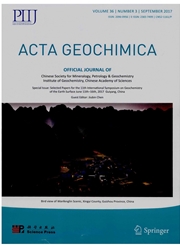

 中文摘要:
中文摘要:
啊哈湖是在 Guiyang 城市的西南的一个季节的缺氧的水系统,贵州省,中国。在 SO4 2 集中的季节的变化和他们湖水里以及在支流的同位素的作文在这研究被调查。结果证明河水里的硫酸盐集中从 t14.9 从 0.94 ~ 6.52 mmol/L 和他们的 34S 价值范围并且 0.9 当湖水有硫酸盐集中从 1.91 ~ 2.79 时, mmol/L,和 34S 从 9.8 ~ 5.9 珍视。煤采矿排水是在啊哈湖的 SO4 2 的主要来源,这被建议。降雨,污水分泌物,硫化物氧化和石膏溶解做了仅仅有限的贡献。溶解 SO4 2 和 34S 的不同深度依赖者分布在夏天和冬季为 DB 和 LJK 被开发。由于水翻, 34S 价值在冬季和春天显示同质的垂直分布。当时在夏天和秋天, 34S 的重要积极移动清楚地由于水层化在 epilimnion 和底部阶层被观察。在 epilimnion 的高 34S 价值可以在水层化期间源于雨水的保留。由细菌的 Dissimilatory 硫酸盐减小被认为为 hypolimnion 的 34S 价值的增加负责。
 英文摘要:
英文摘要:
The Aha Lake is a seasonal anoxic water system in the southwest of Guiyang City, Guizhou Province, China. Seasonal variations in SO42- concentrations and their isotopic compositions in lake water as well as in the tributaries were investigated in this study. The results showed that sulfate concentrations in river water range from 0.94 to 6.52 mmol/L and their δ34S values range from -14.9‰ and 0.9‰, while lake water has sulfate concentrations ranging from 1.91 to 2.79 mmol/L, and 834S values from -9.8‰ to -5.9‰. It is suggested that coal mining drainage is the major source of SO42 in the Aha Lake. Rainfall, sewage discharge, sulfide oxidation and gypsum dissolution have made only limited contributions. Different depth-dependent distributions of dissolved SO4 2- and δ34S were developed for both DB and LJK in summer and winter. Due to water overturn, δ34S values display homogenous vertical distributions in winter and spring. While in summer and autumn, significant positive shifts of δ34S were clearly observed in epilirmtion and bottom strata as a result of water stratification. High δ34S values in epilimnion may result from the retention of rainwater during water stratification. Dissimilatory sulfate reduction by bacteria was thought to be responsible for the increase of δ34S value in hypolimnion.
 同期刊论文项目
同期刊论文项目
 同项目期刊论文
同项目期刊论文
 Strontium isotopic compositions of dissolved and suspended loads from the main channel of the Yangtz
Strontium isotopic compositions of dissolved and suspended loads from the main channel of the Yangtz Study of a coupled model of water hydrodynamics and water quality for YuQiao Reservoir of Haihe Rive
Study of a coupled model of water hydrodynamics and water quality for YuQiao Reservoir of Haihe Rive Geochemistry of the dissolved load of the Changjiang Basin rivers: Anthropogenic impacts and chemica
Geochemistry of the dissolved load of the Changjiang Basin rivers: Anthropogenic impacts and chemica Seasonal variations in sulfur isotopic composition of dissolved SO42- in the Aha Lake, Guiyang and t
Seasonal variations in sulfur isotopic composition of dissolved SO42- in the Aha Lake, Guiyang and t Assessment of the Sources of Nitrate in the Changjiang River, China Using a Nitrogen and Oxygen Isot
Assessment of the Sources of Nitrate in the Changjiang River, China Using a Nitrogen and Oxygen Isot Assessment of atmospheric sulfur with the epilithic moss Haplocladium microphyllum: Evidences from t
Assessment of atmospheric sulfur with the epilithic moss Haplocladium microphyllum: Evidences from t Synchronous variations of precipitation and temperature at Lake Qinghai, NE Tibetan Plateau during t
Synchronous variations of precipitation and temperature at Lake Qinghai, NE Tibetan Plateau during t Mosses indicating atmospheric nitrogen deposition and sources in the Yangtze River drainage basin, C
Mosses indicating atmospheric nitrogen deposition and sources in the Yangtze River drainage basin, C Geochemistry of dissolved inorganic carbon and carbonate weathering in a small typical karstic catch
Geochemistry of dissolved inorganic carbon and carbonate weathering in a small typical karstic catch Chemical and strontium isotope characterization of rainwater in karst virgin forest, Southwes China.
Chemical and strontium isotope characterization of rainwater in karst virgin forest, Southwes China. Rare earth elements patterns in the karst terrain in Guizhou Province, China: Implication for water/
Rare earth elements patterns in the karst terrain in Guizhou Province, China: Implication for water/ Stable sulphur and nitrogen isotopes of the moss Haplocladium microphyllum at urban, rural and fores
Stable sulphur and nitrogen isotopes of the moss Haplocladium microphyllum at urban, rural and fores Sulfur isotopic composition and source identification of atmospheric environment in central Zhejiang
Sulfur isotopic composition and source identification of atmospheric environment in central Zhejiang Hydrogenchemistry and dissolved inorganic carbon isotopic composition on karst groundwater in Maolan
Hydrogenchemistry and dissolved inorganic carbon isotopic composition on karst groundwater in Maolan Atmospheric total gaseous mercury (TGM) concentrations and wet and dry deposition of mercury at a hi
Atmospheric total gaseous mercury (TGM) concentrations and wet and dry deposition of mercury at a hi Elevated atmospheric deposition and dynamics of mercury in a remote upland forest of Southwestern Ch
Elevated atmospheric deposition and dynamics of mercury in a remote upland forest of Southwestern Ch Continuous degradation of 2-naphthol and its metabolites by coupling Aspergillus niger with Bacillus
Continuous degradation of 2-naphthol and its metabolites by coupling Aspergillus niger with Bacillus Fe isotope compositions of natural river and lake samples in Karst area, Guizhou province, SW China.
Fe isotope compositions of natural river and lake samples in Karst area, Guizhou province, SW China. Seasonal variations of sulfur isotopic compositions of dissolved SO42-in Aha Lake, Guiyang and their
Seasonal variations of sulfur isotopic compositions of dissolved SO42-in Aha Lake, Guiyang and their Anthropogenic Inputs of Boron into Urban Atmospheric Environment: Evidence from Boron Isotopes of Pr
Anthropogenic Inputs of Boron into Urban Atmospheric Environment: Evidence from Boron Isotopes of Pr 期刊信息
期刊信息
